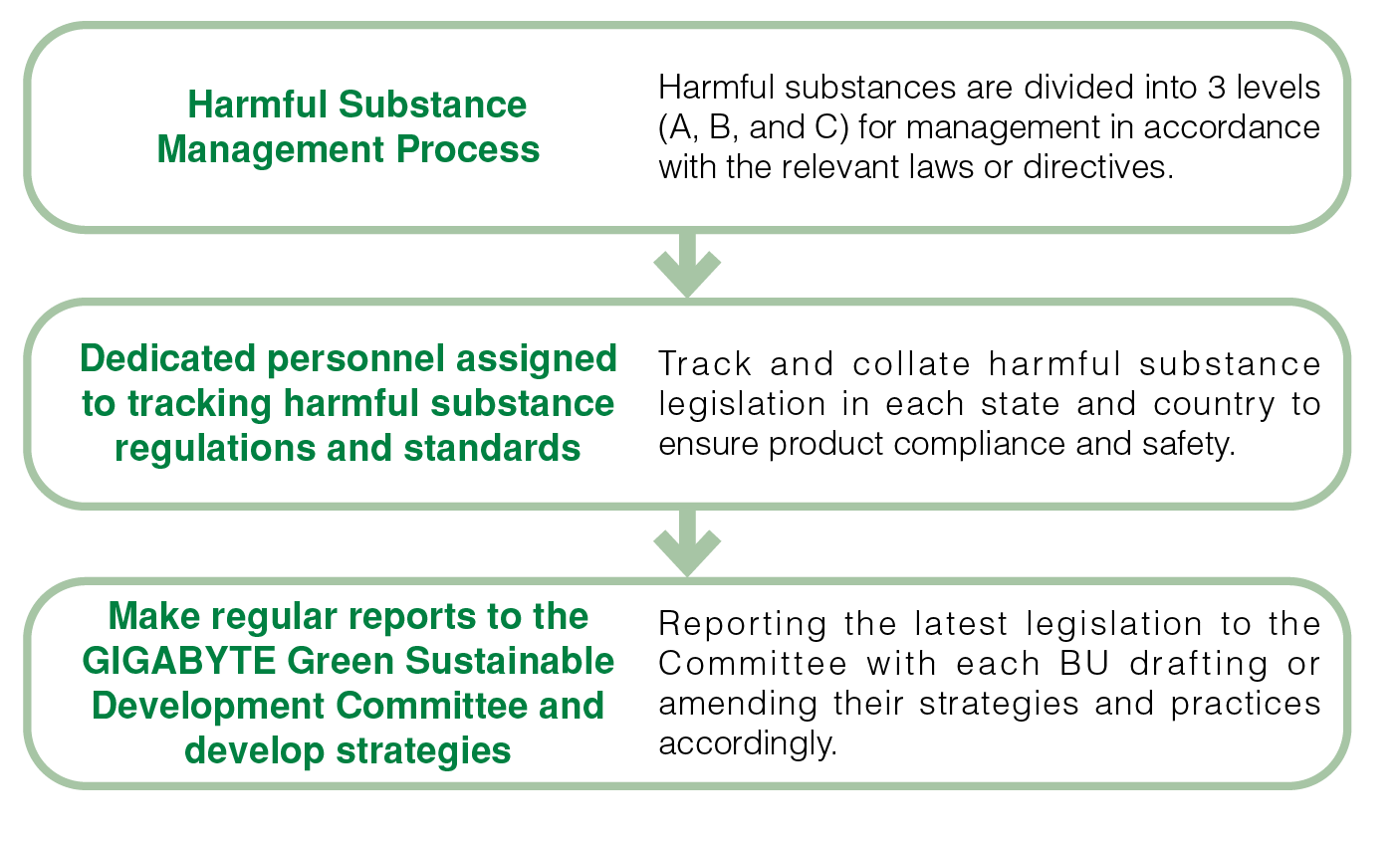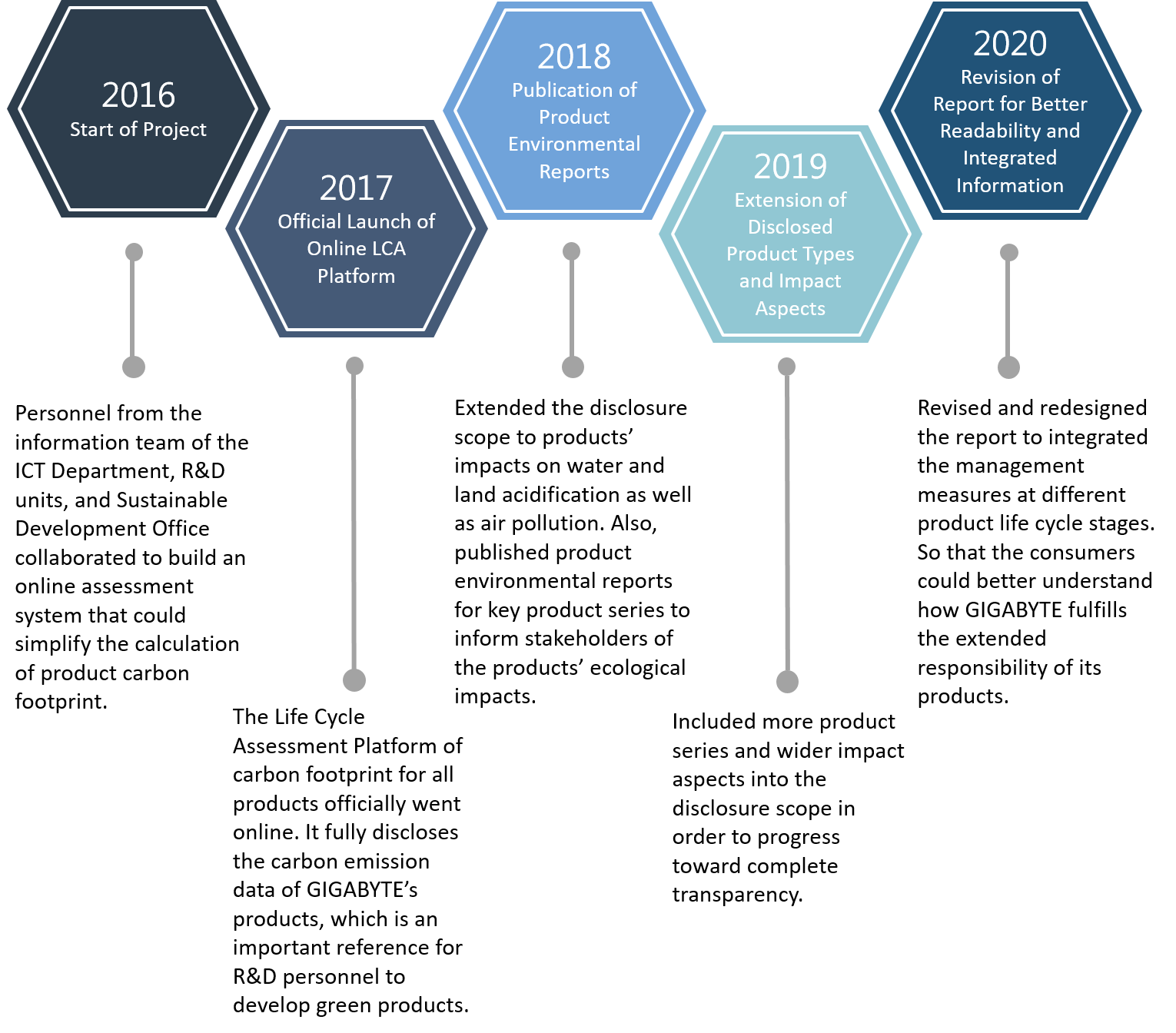Extend Product Responsibility and Guard Society and the Planet together with YOU
GIGABYTE attaches great importance to producer responsibility to society and the environment. We do not support or tolerate any upstream partner that violates human rights and environmental well-being. Besides, by means of continually strengthening employee care, process safety, and environmental management measures on the front line, we insist on ensuring that the products and services to be provided to consumers and customers are safe, environmental-friendly, and of high quality. As for the demand side, GIGABYTE will also restrict or cease business with the third party until and unless we have high confidence that our products are not being used to violate human rights.
Harmful Substance Management Commitment
The “GIGABYTE Harmful Chemical Substance Regulations (HCSR)” was formulated by GIGABYTE to promote sustainable procurement. All products and services purchased by the Company must reduce the use of environmentally harmful substances. All suppliers must evaluate their operations for compliance with REACH, RoHS, WEEE, and other relevant regulations.
Harmful Substance Management Process

Definition of the Environmental Management Substances Level
GIGABYTE classifies harmful substances into three levels: Level A prohibited substances, Level B prohibited substances with time limits, and Level C potentially prohibited substances in the future. A total of 34 categories of substances are under control.
-
Level A: Prohibited Chemical SubstancesSubstances whose intentional use and manufacture are prohibited by existing laws and regulations. Therefore, they cannot be used in all materials, parts consisting of GIGABYTEʼs products, and in production processes.
-
Level B: Restricted Chemical Substances (with a period limitation of banned substances)Prohibition of chemical materials besides Level A is gradually being with the laws, treaties, regulations, or company policies identified with the prohibition of the targeting dates.
-
Level C: Monitored Chemical Substances (content must be reduced)Chemical substances which have no alternatives and for which the target dates of prohibition cannot be set now.
RoHS Exemptions
If the content of environment-related substances exceeds the maximum allowable concentration level established by GIGABYTE and falls within the categories of RoHS exemption, indicate that such substances are exempted items.
| Key Harmful Chemical Substances Regulations | Date of Introduction |
|---|---|
| All products comply with the requirements of EU RoHS 2002/95/EC (In some regions, such as Brazil and India, the introduction of RoHS was completed in January, 2008) |
2006/07/01 |
| All products comply with the requirements of EU RoHS 2011/65/EU | 2013/01/01 |
| All products comply with the requirements of (EU) 2015/863 | 2017/07/01 |
Product Environmental Impact Assessment
GIGABYTE established strict Supplier Management Requirements, in accordance with HCSR, RBA Code of Conduct, and so on. In addition, in order to efficiently compare the environmental impacts of various raw materials and production processes, GIGABYTE has adopted the proven PAS 2050 system for the assessment of life cycle greenhouse gas emissions of goods and services. After an initial carbon impact assessment, we carried out a full product carbon footprint assessment in 2016. Based on the characteristics of GIGABYTE products, we took reference from the methodology of the International Reference Life Cycle Data System (ILCD), and then gradually expanded the scope from our products themselves to their impacts on land/water acidification and air quality (PM2.5). In 2019, the scope of disclosure extended again to cover 12 categories in order to more comprehensively quantify the environmental, social, and health impacts of the product. The implementation strategies and results of our product life cycle assessment project are as follows:

The disclosures through the LCA platform and product environmental reports enable our R&D staff to quickly check the environmental impacts of all raw materials and production processes and identify hot spots for improvement and raise the efficiency and efficacy of our green product development.
Product Environmental Report
Through a product environmental report, one can find the environmental impacts that a product causes throughout its lifetime (material acquisition, manufacturing, transportation, use, disposal, etc.). In addition, one can also learn about the recycling methods, or participate in the latest CSR activities held by GIGABYTE. Let us start with understanding, and take the first step to protect the environment!
GIGABYTE will keep endeavoring to achieve the goal of full product disclosure and look forward to working together with the industry to strengthen the transparency of product information.
The GIGABYTE has published 3 versions of Product Environmental Report with different scope of disclosure:
| Version | Year Adopted | No. of copies | Disclosed Environmental Impact (based on EU Product Environmental Footprint (PEF)) | Other Information |
|---|---|---|---|---|
| Version 1 [V1] | 2018 | 21 | 3 impacts: greenhouse gases; suspended particles; terrestrial/aquatic acidification | |
| Version 2 [V2] | 2019 | 37 | 12 impacts: climate change; ionizing radiation; particulate matter; ozone depletion; photocatalytic ozone formation; mineral, fossil, and raw resource depletion; acidification; freshwater eutrophication; terrestrial eutrophication; freshwater ecotoxicity; human toxicity (cancer effects); human toxicity (non-cancer effects). | |
| Version 3 [V3] | 2020 | 97 | 16 impacts: climate change; particulate matter; ozone depletion; water use; freshwater eutrophication, marine eutrophication; resource use (energy carriers); resource use (minerals and metals); land use; terrestrial eutrophication; photochemical ozone formation; acidification; freshwater ecotoxicity; human toxicity (cancer effect), human toxicity (non-cancer effect); ionizing radiation. | Composition and recycling ratios of the materials used in the product and packaging. |
- Home
- Innovation Management
- The Guanxi Blue Zone
- The Ocean is Our Home
- From the Chairman
- Commitment to CSR
- Stakeholder Engagement
- Material Topics
- SDGs
- Corporate Organization
- Code of Conduct
- Information Security & Privacy
- Risk Management
- Supply Chain Management
- Tetralogy of Supply Chain Engagement
- Conflict Mineral
- Environmental Management Policy
- Brand Strategy and Business Reputation Management
- Climate Strategy and Risk Management
- Customer Relations Management
- Eco-friendly Product
- Extended Product Responsibility
- Biodiversity
- Circular Economy
- Green Action
- Sustainability/Environmental Education
- Green Activities
- Working Holiday
- Corporate Volunteering
- Go Green Taiwan
- Make Earth Green Again
- Tree Map
- Overview/Core Concept
- Rooftop Farm
- Ecology Photo Competition
- Sustainability-related Certification
- Diverse and Inclusive Workplace
- Talent Management
- Human Rights Management
- Talent Cultivation and Development
- Occupational Safety
- Health Care
- Upgrade Your Life
- Social Inclusion
- CSR Milestone
- Economic Aspect
- Environmental Aspect
- Social Aspect
- CSR Report
